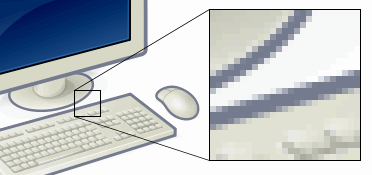Fundamentals of Data Representation: Bitmaps
Overview
[edit | edit source]

Resolution
[edit | edit source]

Example
[edit | edit source]|
Example: Calculating screen resolutions Using the diagram above we are going to work out how many pixels are required to display a single frame on a VGA screen. Checking the resolution: Height = 480 Width = 640 Area = Width * Height = Total Pixels Area = 640 * 480 = 307200 |
Questions
[edit | edit source]|
Exercise: Calculating screen resolutions What is a Pixel? Answer: The smallest possible addressable area defined by a solid colour, represented as binary, in an image. What is Image Resolution? Answer: The amount of pixels an image contains per inch/cm What is Screen Resolution? Answer: the number of pixels per row by the number of pixels per column What is the resolution of a 100 pixel by 70 pixel image? Answer: 100 * 70 = 7000 pixels What is the resolution of a 30 pixel by 40 pixel image? Answer: 30 * 40 = 1200 pixels What is the resolution of HD 1080p image? (use the diagram above to help) Answer: 1920 x 1080 = 2073600 pixels If I have an image resolution of 700 pixels, and the height is 35, what is the width of the image? Answer: 700 / 35 = 20 pixels What is a benefit of having a higher resolution image? Answer: higher resolution images are able to display more detail, providing crisper images What might be a draw back of having a very high resolution image Answer:
It will require a lot of space to store it. Meaning you'll quickly run out of memory, or it'll take a long time to transmit images across the internet or other data route.
|
Colour Depth
[edit | edit source]
| Colour depth | 1 bit | 2 bit | 4 bit |
|---|---|---|---|
| Example |  |
 |

|
| Description | Mono-chrome, only stores black and white | stores 4 colours: RGB(70,61,55), RGB(79,146,85) RGB(129,111,134), RGB(149,146,166) |
Stores limited colours |
| Number of colours per pixel |
|||
| Colour depth | 8 bit | 24 bit | |
| Example |  |

| |
| Description | close to reality | hard to see any difference between reality | |
| Number of colours per pixel |
It seems pretty obvious that the higher the colour depth, the closer the picture will look to reality. Why then don't we just ramp up the colour depth on every image that we make? The answer should be obvious, for a fixed resolution, the higher the colour depth, the larger the file size.
Example
[edit | edit source]|
Example: Calculating file size for different colour depths All the images above are of the same resolution: 300*225 = 67500 pixels If the first image uses 1 bit to store the colour for each pixel, then the image size would be: Number of Pixels * Colour Depth = Image Size
67500 * 1 bit = 67500 bits
For the second image uses 2 bits to store the colour for each pixel, then the image size would be: Number of Pixels * Colour Depth = Image Size
67500 * 2 bit = 135000 bits
| ||||||
Questions
[edit | edit source]|
Exercise: Colour Depth What does colour depth mean? Answer: The number of bits used to represent the colour of a single pixel For a colour depth of 8 bits, how many colours could each pixel store? Answer:
To represent 1024 colours per pixel, what colour depth would I need? Answer:
For an image of 30 by 40 pixels, what would the file sizes be for the following colour depths: 4 bits Answer:
6 bits Answer:
2 bits Answer:
How many colours can each pixel store if it has a colour depth of 4bits? Answer:
How many bits does the colour depth have to be if we want to store 64 colours per pixel? Answer: 6 as:
How many bits would an image be that has a size of 20 by 30 pixels, with each pixel able to display 8 colours? Answer: 8 colours is 3 bits per pixel as: When might one want to decrease the colour depth for an image? Answer: When you want to save file space or when you only need a specific palate of colours such a mono-chrome |











